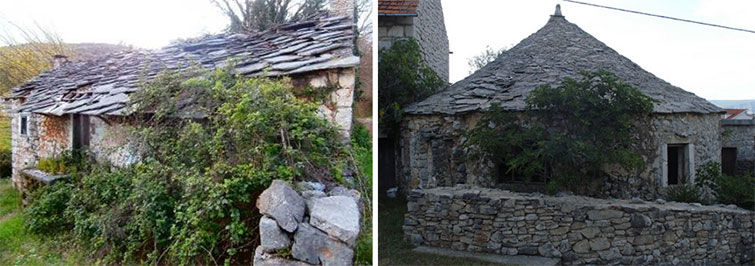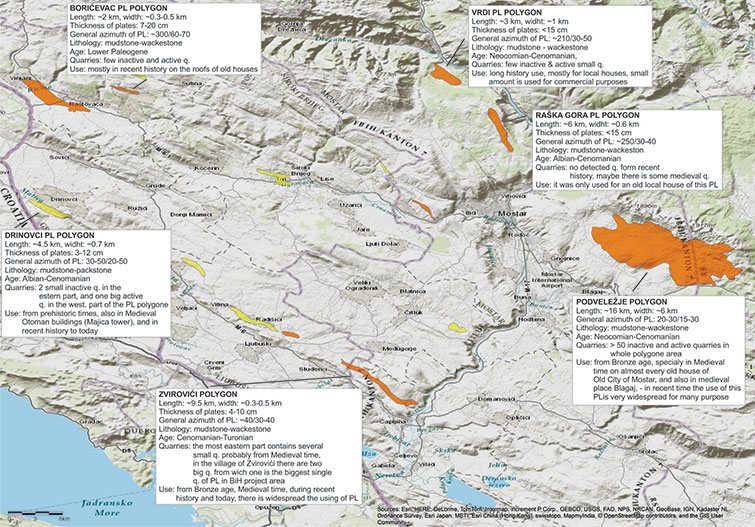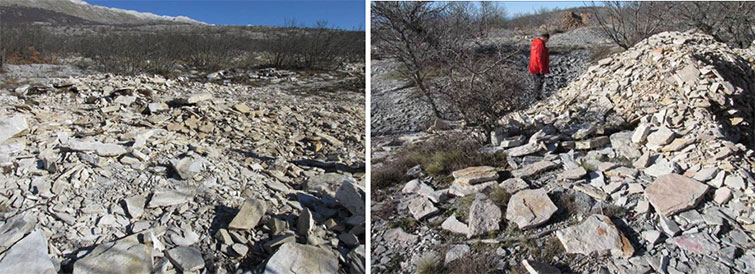Platy limestone – geologic definition and its use as a mineral commodity
Jernej Jež, Uroš Barudžija, Sara Biolchi, Stefano Devoto, Goran Glamuzina, Tvrtko Korbar
There are several examples of best practice within the project area in Herzegovina in using PL as a building material. The best examples of best practice is the use of Cretaceous platy limestone in: the Old town of Mostar, which is included on UNESCO's list of protected sites, the medieval Old town of Počitelj, Blagaj, Stolac, and many other very old buildings and objects (Fig. 2.34). As possible bad examples there can be specified where the youngest Miocene platy marly limestone were used in the project area as building material for the walls and specially for the stairs, where many parts of these stones were destroyed over time due to their lower quality.

Platy limestone in the project area in Herzegovina is mainly of a light grey to dark grey colour, and of mudstone to packstone structural types. It also often contains distinctive stromatolitic and horizontal lamination. In all of the types of Cretaceous limestone, almost 99 per cent of internal components are made of calcium carbonate, while in the Eocene limestone, and particularly in Miocene limestone, an increased proportion of clay or marly components are also present. This is reflected as an increase of lenses of marls and sandstones within the limestone sequences. In general, most of the PL sequences are only a few metres thick, in places less than a metre.
The data on potential and high-potential PL types mapped on a scale of 1:50,000 served as a basis for the evaluation as a mineral commodity and for the identification of potential quarrying areas. In the southern part of the project area, several potential areas with platy limestone can be defined:
According to the descriptions of the considered polygons with platy limestone, the basic qualitative characteristics and the potential for further exploitation, as well as the quantities of platy limestone in the quarries can be estimated. The general synthesis of the qualitative and quantitative characteristics for each polygon is shown in the Figure 2.35.

The highest potential for further exploitation of platy limestone is in the Podveležje area east of Mostar due to its large spatial extent, the thickness of succession and due to the very high quality of the platy or well-bedded limestone. A large number of active and abandoned quarries of high-quality platy limestone mark the area (Fig. 2.36). PL is being exploited today in numerous small quarries and represents the most commercial type of platy limestone in the project area. Limestone from the Podveležje is provided by many stone dealers and suppliers in Herzegovina.

Another high potential polygon for further exploitation of platy limestone is the Raška gora site polygon, in which a thick sequence of high-quality platy limestone has been determined. The zone, in the northern part of the Raška gora karst plateau, has been discovered, described and evaluated in detail during the fieldwork for this project.
Furthermore, in the eastern part of the Zvirovići site polygon, high quality platy limestone provides a high potential for further exploitation (Fig. 2.37) and their use for building and construction purposes, especially for the roofing of houses. Platy limestone from the Zvirovići and Podveležje sites is also the most extensively and commercially used PL in architecture and construction, among the platy limestone from all the sites described.

In addition to the aforementioned PL site, the other important and high-potential sites with large spatial extents of Cretaceous platy limestone are the Vrdi and Drinovci zones. In Borićevac, a Lower Paleogene site of also very high-quality platy limestone occurs (Fig. 2.38). The active quarries and the tendency to develop further excavation indicate the high potential for these platy limestone sites. Additionally, the potential for further exploitation at these localities and PL use in architecture can be clearly seen in many old and historical houses, which are roofed with platy limestone from these sites.

In several of the investigated sites, fossil macrofauna was found, which from some of them was already known and described. Due to the visual attractiveness, rarity and scientific value of these macrofossils, three sites have been selected and proposed as geo-sites: Raška gora, Kolojanj, and Grabova draga. Besides the valuable macrofossils, interesting sedimentological profiles are also present at these sites, and the most valuable profile is at the Grabova draga geo-site. Raška gora and Kolojanj geo-sites contain limestone from the Cretaceous period, while the Grabova draga presents Eocene platy limestone succession (see Appendix 2.4).
It is important to note that even today laws and regulations related to commercial exploitation of mineral resources in the Federation of BiH are not well defined. This is especially the case at the county level and the consequences are clearly visible in the field, particularly in small local quarries without mining right. However, the possibility for further exploitation of platy limestone in the project area can be generally estimated as potential to highly potential.
The preferential use of local stones, determined and described in detail within this study, is recommended from a geological point of view for future conservation and building purposes. These will greatly contribute to the preservation and protection of the natural and cultural heritage of Herzegovina, as one of the most-known karst areas in the world.
Gathering and picking up limestone plates on the surface using hand tools, which was also a good practice in the past, is also highly recommended for the future in order to preserve and protect the non-material heritage of Herzegovina.










